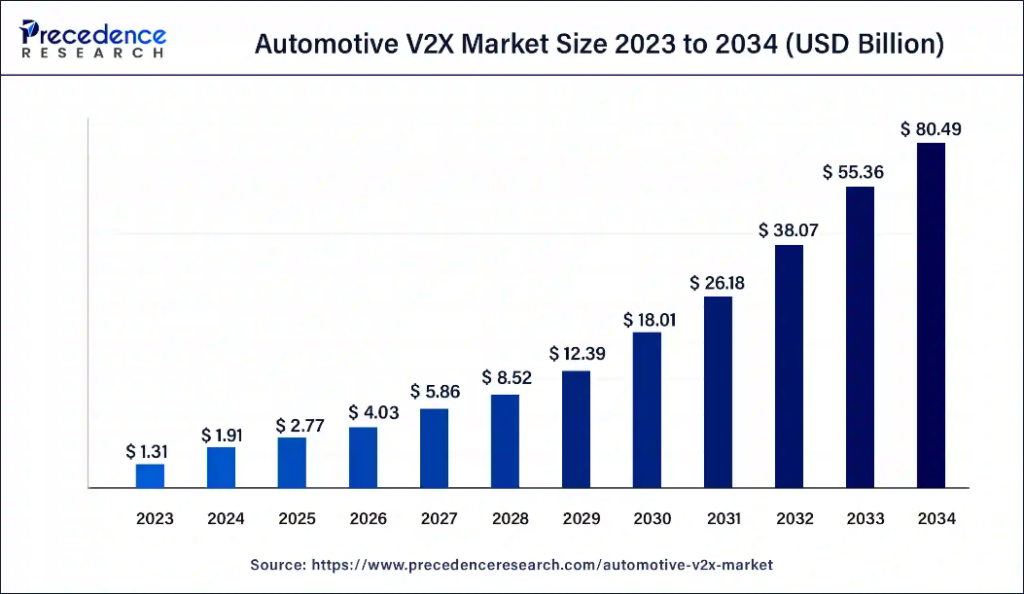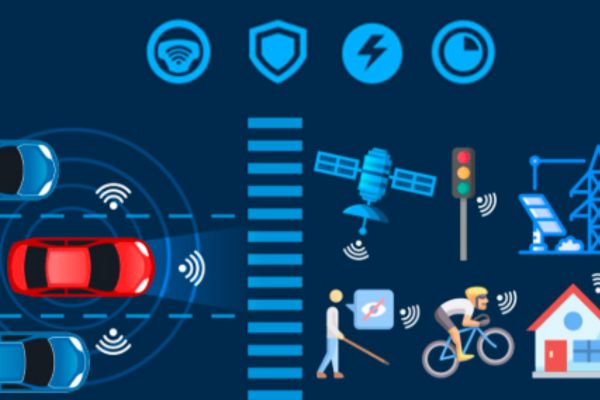The global automotive V2X market size was exhibited at USD 1.91 billion in 2024 and is projected to hit around USD 80.49 billion by 2034 with a significant CAGR of 45.37% from 2025 to 2034.

Automotive Vehicle-to-Everything (V2X) is a transformative wireless communication technology that enables vehicles to interact with virtually any entity in their environment, including other vehicles (V2V), infrastructure such as traffic lights and road signs (V2I), pedestrians and cyclists (V2P), networks (V2N), and more. By allowing real-time data exchange, V2X enhances road safety, traffic efficiency, and environmental sustainability. For example, V2X-equipped vehicles can warn each other of hazards beyond line of sight, such as accidents around a corner or emergency vehicles approaching, and can receive updates from infrastructure about traffic conditions, roadworks, or air quality. This technology operates using both dedicated short-range communications (DSRC) and cellular-based standards, ensuring robust connectivity even in challenging environments. V2X is seen as a foundational element for the future of autonomous driving, offering benefits like reduced traffic congestion, lower emissions, improved mobility for all road users, and the potential to significantly decrease accident rates through proactive hazard awareness and coordinated driving actions. As adoption grows, V2X is expected to play a central role in the development of intelligent transportation systems and smart cities worldwide.
Role of AI in Transforming the Automotive V2X Market
Artificial intelligence (AI) plays a crucial role in the automotive V2X (vehicle-to-everything) market by enhancing the way vehicles communicate with each other and their surroundings. V2X technology enables vehicles to exchange real-time information with other vehicles, infrastructure, pedestrians, and the grid, which is essential for improving road safety, traffic efficiency, and supporting autonomous driving. AI optimizes these communication processes by enabling vehicles to analyze vast amounts of data, predict potential hazards, and make informed decisions instantly, even in complex traffic scenarios. This leads to proactive accident prevention, smoother traffic flow, and more energy-efficient driving. The integration of AI also supports the development of autonomous vehicles, as it allows them to navigate safely in situations that go beyond the capabilities of traditional onboard sensors. With ongoing advancements in 5G and communication networks, AI-driven V2X solutions are expected to accelerate market growth, drive innovation, and contribute to the creation of smarter, safer, and more connected transportation systems worldwide
Regional Insights
Will Asia Dominate the Automotive V2X Market?
With a commanding 42% market share in 2023, the Asia Pacific region is the largest and fastest-growing market for automotive V2X. The regional market is projected to grow from USD 800 million in 2024 to an impressive USD 33.81 billion by 2034, showing aggressive investment and adoption. This growth is driven by rapid urbanization, the surge in electric vehicle production, and government-backed smart city initiatives in countries like China, Japan, and South Korea. China’s strong push for connected vehicle infrastructure and 5G rollout is a major catalyst in the region’s dominance.
North America holds 28% of the global V2X market as of 2024. The U.S. leads this growth due to a well-established automotive industry, early adoption of 5G, and federal initiatives supporting V2X integration. Key players in the region such as Ford, GM, and Qualcomm are actively developing C-V2X and DSRC technologies. With supportive policies and safety mandates, North America is poised to remain a prominent force in the medium to long term.
Europe commands a 24% market share in 2024, marked by strong policy frameworks and a proactive stance toward road safety and emissions. The European Commission’s Cooperative Intelligent Transport Systems (C-ITS) strategy is central to advancing V2X. Countries like Germany, France, and the Netherlands are investing in real-world pilots and public-private partnerships. Automakers like BMW, Volkswagen, and Daimler are pioneers in integrating V2X features across their fleets.
Market Scope
| Report Highlights | Details |
| Market Size in 2024 | USD 1.91 Billion |
| Market Size in 2025 | USD 2.77 Billion |
| Market Size by 2034 | USD 80.49 Billion |
| Growth Rate from 2025 to 2034 | CAGR of 45.37% |
| Largest Market | North America |
| Fastest Growing Market | Asia Pacific |
| Base Year | 2024 |
| Forecast Period | 2025 to 2034 |
| Segments Covered | Communication Type, Vehicle Type, Connectivity Type, Regions |
| Regions Covered | North America, Asia Pacific, Europe, Latin America, Middle East and Africa |
Automotive V2X Market Market Dynamics:
Safety and Efficiency Drivers: V2X technology enables real-time communication between vehicles, infrastructure, pedestrians, and networks, which improves situational awareness, collision avoidance, and traffic flow optimization. This reduces accidents, traffic congestion, and emissions, aligning with global road safety mandates and urban mobility goals.
Technology Advancements: The rise of 5G and cellular V2X (C-V2X) technologies enhances communication range, latency, and scalability, making V2X more effective and easier to integrate with existing automotive and smart city infrastructure. Hardware innovations such as multi-band antennas, edge computing, and compact, energy-efficient modules are facilitating widespread adoption in passenger and commercial vehicles.
Government and Regulatory Support: Many governments, including the U.S. Department of Transportation, are actively promoting V2X deployment through smart city initiatives and regulatory frameworks aimed at reducing traffic accidents and improving transportation efficiency. However, challenges remain in establishing robust legal frameworks and ensuring data security and privacy in V2X communications.
Influence of Electric and Connected Vehicles: The surge in electric vehicle (EV) sales and the proliferation of connected cars are fueling V2X adoption, as EVs often come equipped with advanced driver-assistance systems (ADAS) that benefit from V2X capabilities. Regions like China, Europe, and North America are leading in EV adoption and connected vehicle deployment, further propelling the V2X market.
Opportunities and Challenges: The expanding smart city projects and increasing urbanization offer substantial growth opportunities for V2X technology providers, automotive OEMs, and infrastructure developers. However, the market must address challenges related to system security, privacy, interoperability, and the establishment of comprehensive regulatory standards to fully realize V2X’s potential.
Automotive V2X Market Segmentations
Communication Type Analysis
Vehicle-to-Infrastructure (V2I):
V2I communication involves the exchange of data between vehicles and roadway infrastructure such as traffic signals, signage, and toll booths. This segment plays a crucial role in enhancing traffic management, reducing congestion, and improving road safety. By enabling real-time communication, V2I helps optimize signal timing and route planning, contributing to smarter urban mobility and better fuel efficiency.
Vehicle-to-Grid (V2G):
V2G technology allows electric vehicles (EVs) to interact with the power grid. In this model, EVs can feed unused electricity back into the grid or draw energy when required. V2G not only supports grid stability and energy storage but also paves the way for more sustainable energy consumption models. As EV adoption grows, this segment is expected to witness significant expansion due to its potential in demand response and renewable energy integration.
Vehicle-to-Vehicle (V2V):
V2V communication allows cars to share data such as speed, location, and direction with other nearby vehicles. This information exchange is essential for collision avoidance, lane-changing assistance, and overall situational awareness. V2V is a cornerstone of autonomous driving technology and is expected to significantly reduce accidents caused by human error, enhancing both passenger and pedestrian safety.
Vehicle-to-Home (V2H):
In V2H communication, EVs act as energy sources for residential power needs. By supplying stored energy back to a home during peak hours or outages, V2H offers a resilient and cost-effective energy solution. This segment is gaining traction in regions with high residential solar adoption and fluctuating grid reliability, making it a part of the larger smart home ecosystem.
Vehicle-to-Pedestrian (V2P):
V2P enables vehicles to communicate with pedestrians via their smartphones or wearable devices. This segment enhances safety in urban environments, particularly at intersections and crosswalks. V2P is vital in reducing pedestrian accidents and is increasingly being integrated into city planning and intelligent transport systems.
Vehicle-to-Network (V2N):
V2N encompasses communication between vehicles and cloud-based services or networks. This includes updates on traffic, weather, road conditions, and infotainment. V2N supports the delivery of advanced driver-assistance systems (ADAS) and real-time navigation, making the driving experience safer, more convenient, and efficient.
Vehicle Type Analysis
Commercial Vehicles (CV):
This segment includes trucks, buses, and other vehicles used for logistics, public transport, and industrial purposes. CVs benefit greatly from V2X technologies, especially V2I and V2V, which improve route efficiency, reduce delivery times, and enhance fleet management. As logistics companies seek smarter transportation solutions, the demand for V2X-enabled commercial vehicles continues to grow.
Passenger Cars:
The integration of V2X in passenger cars focuses on improving safety, comfort, and infotainment features. Automakers are increasingly equipping vehicles with communication technologies to support autonomous driving and driver assistance systems. The growing consumer preference for connected and smart vehicles is fueling growth in this segment, especially in urban and developed markets.
Connectivity Type Analysis
Cellular Connectivity:
Cellular V2X (C-V2X) leverages mobile networks (like 4G and 5G) for high-speed, low-latency communication. It supports both direct and network-based communication, making it suitable for a broad range of use cases including autonomous driving and remote vehicle control. The expansion of 5G networks is expected to be a major driver for this segment.
Dedicated Short-Range Communications (DSRC):
DSRC is a Wi-Fi-based communication standard designed specifically for automotive use. It supports low-latency and high-reliability communication in localized environments, making it ideal for V2V and V2I applications. Though its adoption has been challenged by the rise of C-V2X, DSRC remains relevant, especially in regions with early deployment and regulatory backing.













